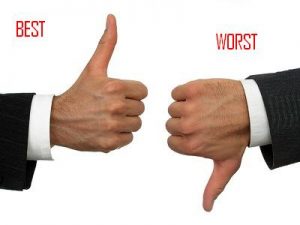This is a tactic which I use whenever I have to make a choice, take a tough decision or to do anything which gets me thinking. I call it the “Best and Worst Case Score” tactic. I have been using this tactic for quite some time now and it has made many of my decisions an easy choice which otherwise would have looked daunting. I have used it to handle choices/decisions ranging from professional life to family / friends related issues to just day to day small choices. Normally we tend to regard situations as more important and serious than they actually are. Using this technique has helped me differentiate between the seemingly important decisions and the really important ones.
The Tactic
When faced with any situation where you have to make a decision or choice and you are confused or stuck somewhere –
- On a scale of 10, give a rating assuming the best case scenario that can happen if you go ahead with the decision. The scale of 10 reflects what impact will the decision make in your life considering your long-term ambitions, values, etc
- Similarly, rate out of 10 the worst case scenario that can happen if things headed in the wrong direction.
- Now compare the scores, and you will know the answer to your confusion
Let me illustrate this with an example. I was thinking of buying a bike since I came to Bangalore. The only bike I wanted to buy was a Bullet, which are very expensive ones. And I had doubts regarding whether I would be able to handle it because of my build. People always advised me to look for a lighter bike which would be more suitable for me. But I only wanted this bike! The dilemma (or what I thought) was that the bike cost upwards of Rs 1 Lakh and all that money would go down the drain if I am unable to manage the bike. I kept on deferring this decision for around 10 months due to the uncertainty, doubts, and all the confusion.
Then finally, I decided to use the “Best and Worst Case Score” tactic. What could be the best case scenario that could happen after buying the bike? The best case was that I would be able to easily handle the bike. I would go on long rides and travel to different places, and can have the experience of a lifetime. I rated this as a 8/10. Then I looked at the worst case scenario. I might not be able to handle the bike due to its weight, and it would be a waste of money. In that case, lets say after 1 year of unsuccessfully trying to ride the bike, if I have to sell it off, it will easily sell for some 80k as Bullets have a good resale value. So the loss, even in the worst case, will be around Rs 20k. I would rate it as a 2/10 on the worst things that can happen to me.
After evaluating the choices, I think it is very clear what I decided. I did not want to miss a possible 8/10 best case experience due to the fear of a 2/10 worst case scenario. The problem was that I was overestimating the fears in the worst case scenario. And this is very typical human behavior, whenever we seek something new, we tend to over-calculate the negative sides and play it safe. But I made the right choice and have some memorable experiences in the 10 months that I have owned the bike so far.
One can use this tactic for big decisions like changing a job or starting a regular exercise regimen, to small choices like whether to call a friend on his/her birthday, or whether to go home early to spend some time with your family. Sometimes it is amazing how clearly and objectively this tactics presents the picture in front of you. If you use this tactic, sometimes you will think that why the hell were you deferring this decision when the benefits are huge and risks/losses are minimum.

